Y-12 Blog
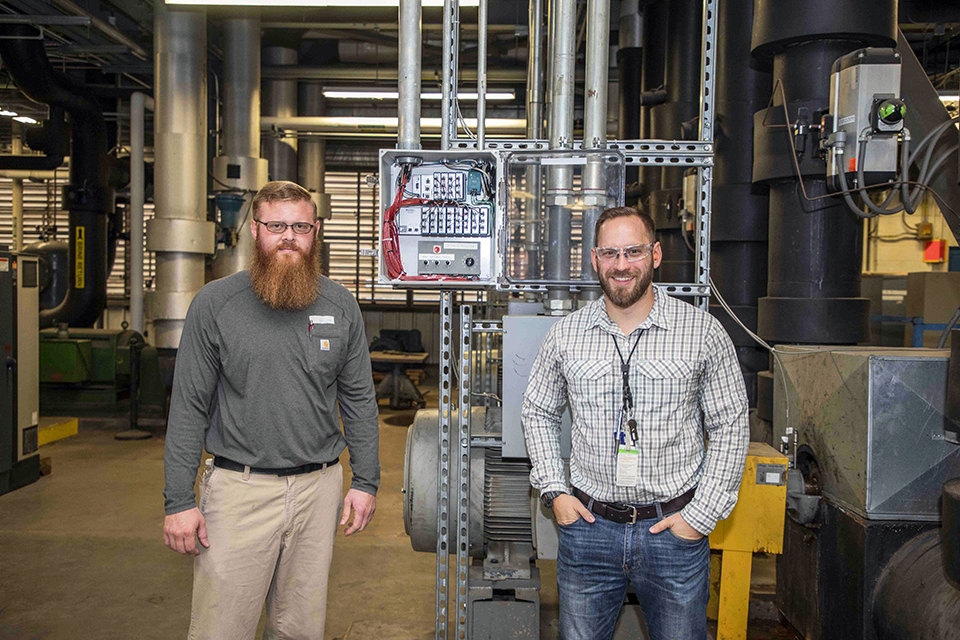
Ronald Bolden Jr. (left) and Luke Birt, pause for a photo with Building 9767-13’s installation
Technology is integrated throughout the modern business world and at the heart of Consolidated Nuclear Security’s digital transformation. It is often the common source credited to improving the quality of processes and systems in our lives. Whether it’s the ability to rapidly gather information from a search engine or track physical performance with a smart watch, many of us can identify how technology simply makes our lives easier and more informed.
With remote tracking and wireless data collection capabilities now also playing a critical role for our people, processes, and systems at Pantex and Y 12, our digital transformation is advancing the modernization of site operations.
“Our team dreamt of digital transformation to support the CNS Strategic Plan,” said Travis Childress, condition based maintenance (CBM) lead engineer. “Specifically, we sought to improve the reliability and availability of aging infrastructure through remote and real-time CBM monitoring.”
By definition, CBM is a monitoring strategy that observes the present condition of an asset or machine to determine what maintenance should be done based on signs of decreased performance or indication of failure.
While the CBM process isn’t new to CNS, the ability to continuously and remotely track a machine in the field using the CBM strategy is transformational.
“Previously, data collection activities required an analyst or craftsperson to physically collect the data in the field. The analyst reviews the data for early detection of failure modes and communicates concerns before equipment reliability is impacted,” said Childress.
Recently, the CBM team began real time machine health monitoring at Y-12, known as the Enterprise Operational Monitoring System. Now, more than 10,000 measurement points can be collected in three second measurement intervals, for analysis using the EOMS dashboard. The result is a robust graphical indication of machine health used to immediately identify the root causes of machine failure and prevent unplanned maintenance. Over time, data trending and patterns can be analyzed to better predict machine maintenance needs and further limit machine downtime.
“The EOMS project is a huge accomplishment for the Digital Transformation program,” said Jerry Stanley, lead for Digital Transformation. “By laying out real time monitoring solutions for CBM, we’re not only modernizing the state of our tracking and sensor operations, but supporting our mission long term with technology that’s industry standard.”
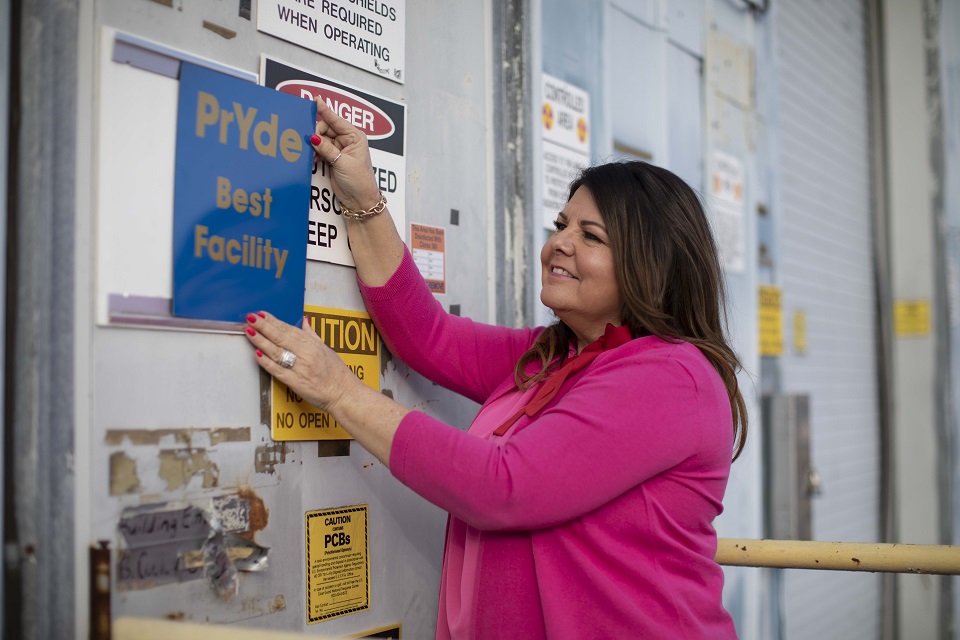
PrYde Program Manager Margaret Woods shows off a Best Facility sign that recognizes Best Practices, one of two new inspection awards given quarterly.
Take 5 minutes and learn about Margaret Woods, manager of the PrYde Program at Y-12. All views and opinions are the employee’s own and do not necessarily reflect those of CNS.
Margaret Woods has gone from the classroom to helping Y-12 facilities be class acts.
Since 2019, Woods has managed the PrYde Program, which finds potential safety hazards, ensures the site’s good appearance, and promotes workplace pride. Before coming to Y-12, she sought to bring out the best in second and third graders as a schoolteacher in Roane and Rhea counties for 28 years.
“Teaching is a passion,” she said. “There are times when I miss it, but I was ready for a change. My audience has always been 7 or 8 year olds, so it was a challenge to start working with adults.”
Woods sees her qualities and experience as a teacher as strengths in her Y-12 post.
“As a teacher, you have to plan ahead,” she said. “You have to plan weeks and months out. Being organized is important, on a personal and professional level. You have to make the most out of your time and energy. And as teachers, we had to be creative with our resources.”
Also, the Rockwood native is a self confessed neat freak, a perfect fit with the PrYde Program principle: A place for everything and everything in its place.
PrYde means “clarifying goals, editing the unessential, honing decision making skills, letting go of things that no longer support you, changing habits, and setting up viable, organizing systems,” said Woods, who also has 11 years of experience as a business manager. “It’s a process that requires time and patience and can be messy. But in the end, it will save time, energy, and money, while boosting safety.”
As PrYde program manager, Woods inspects 413 facilities in 15 zones on more than 800 acres. It’s about housekeeping on the highest level.
During the walk downs, “I look at every aspect of the facility. I look for trends, things that are common,” she said. “It could be ways to be more sustainable. A tenant’s office space may be cluttered with boxes. There may be leaks, which can cause water damage — mold. Equipment could be ruined by the water. Someone could slip and fall in a puddle. Collective little things can really add up.”
Inspections are performed annually. Woods visits 30 to 50 facilities per month. There are five color coded inspection ratings, which are calculated in a database. They range from Red (Unsatisfactory) to Blue (Excellent). In the middle is Green (Meets Expectations). Rating signs with the corresponding color are hung at the facilities after the inspection.
“Our goal is to have every facility be [rated] green or higher,” she said.
During the first quarter of FY 2022, 78% of the facilities inspected rated green or better. Last fiscal year, 84% of 413 facilities were at least in the green.
This year, the program introduced two new quarterly awards: Best Practices and Most Improved. A facility that continues to implement and demonstrate routine housekeeping responsibilities and maintains a Blue (Excellent) rating will be given Best Practices. A facility that exhibits continuous improvements in a wide range of areas, from proper waste to exterior appearance, and elevates its rating from the prior annual inspection will garner Most Improved. The first facilities to boast the signs were Building 9720-9 for Best Practices and Building 9949-39 for Most Improved.
For Woods, her job is more than inspections. It’s also about appreciation for the work done at Y-12.
“Being out there and seeing firsthand what our people do is amazing,” she said. “I learn something new every day. It’s like when I was teaching. I learned a lot from those 7 and 8 year olds.”
What daily task lets you know you’re helping achieve the CNS mission? How does that task let you know you’re working towards the mission?
I think it’s when I get the follow ups. I’ll get an e-mail, and the customers have shared a photo that Photography has taken to show what has happened since the inspection. That tells me things are working and that they value what I’m trying to do.
What is your favorite aspect about your work environment? How does that aspect make you know the mission is being met?
I love seeing a facility move up its rating, whether it’s 2% or 20%. I love changing those signs. That makes me feel successful.
What CNS principle drives you to be successful?
I would have to say having integrity. That’s what we stand for. It’s about being proud of what we do and how we do it. I’m very fortunate to be a part of the mission.
What advice would you offer someone who is new to Y-12?
Make connecting with others a priority. Relationships that you build with another person adds a beam of support to what you’re building.
What one thing would your coworkers be surprised to know about you?
When I was 5 and 6 years old, I was in the Golden Flake Potato Chips commercials. I’m a star. I got free potato chips and got paid, too.
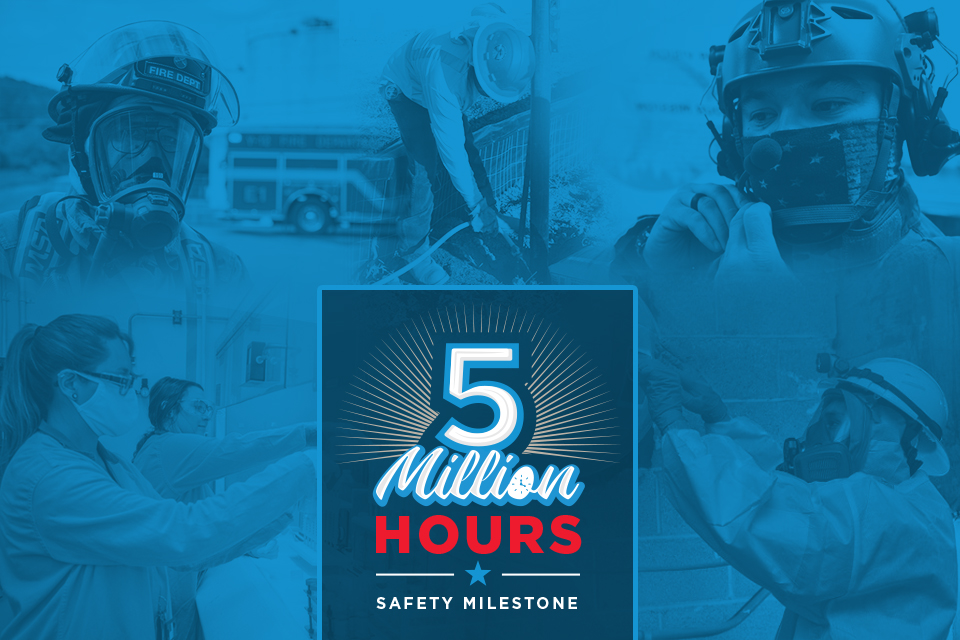
Five million hours. That’s a difficult-to-conceive amount of time. To put it in perspective, you would have to drive back and forth between Amarillo, Texas, and Oak Ridge, Tennessee more than 150,000 times to hit five million hours. Better pack some snacks for the road!
Consolidated Nuclear Security employees achieved the major safety performance milestone of five million hours without a lost-time injury earlier this year, capping off a streak that lasted nearly four months. This includes the performance of CNS workers and the subcontractors for which CNS directs day-to-day activities.
The last time CNS achieved five million hours was in April 2017. According to Environment, Safety, and Health senior directors Jimmy Rogers of Pantex and Jan West of Y-12, the recent accomplishment illustrates the sites’ latest safety strategies and dedication to ensuring workers return to their families safe.
“We’ve taken a boots-on-the-ground approach when it comes to strengthening our safety culture at both sites,” said Rogers. “Our workforce prides itself on keeping one another safe, so we decided to get our organizations across the enterprise directly involved.”
Organizations are capitalizing on the strategies that are working specifically for them through new safety sustainment plans, building on strong safety improvement numbers in 2021. Leadership across the enterprise is supporting efforts to sustain the actions and engrain them into the safety culture. Various incentives to support safety culture have been created, such as the Good Catch Award. Union leadership and safety representatives have also been key in driving improvements.
West shared that all personnel should be proud of this accomplishment, not just ES&H. Reducing lost-time injuries is good for the overall health of the organization, as well as builds confidence in personnel’s families that the safety of their loved ones is a top priority.
“The landscapes at Pantex and Y-12 are changing daily, and so it’s even more exciting to have this safety performance amidst all of the project work. Our workforce takes pride in having a safe environment,” West said. “Our organizations and workforce look out for each other. It takes raising your hand when something doesn’t look right. It’s not just lip service; it’s how we do business here.”
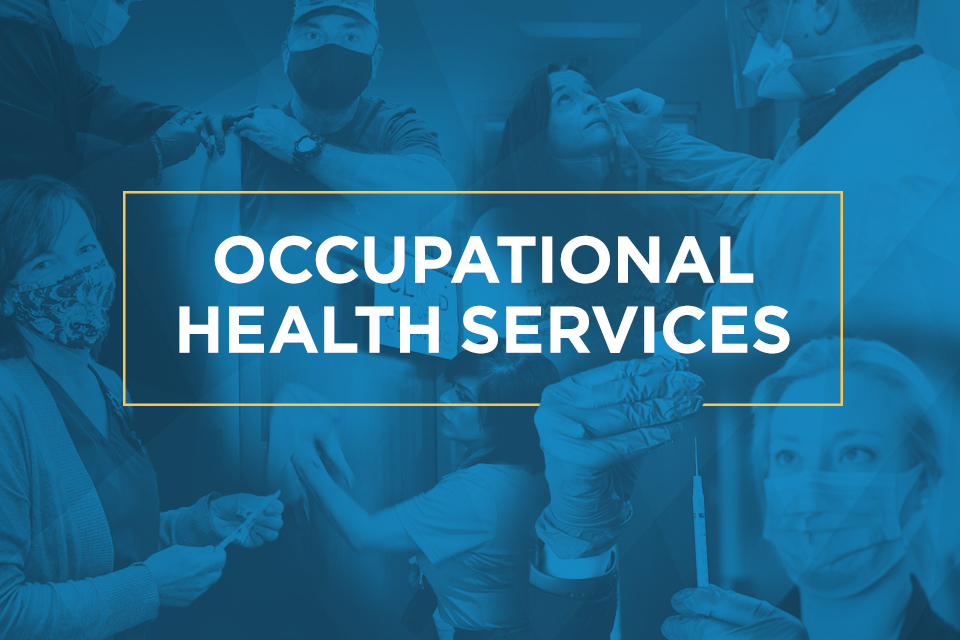
Pantex and Y-12 Occupational Health Services received top scores in all applicable categories in a recent Survey Report conducted by the Accreditation Association for Ambulatory Health Care (AAAHC) and, as a result, both sites were awarded a full three year accreditation. The healthcare accrediting body performs inspections of more than 6,000 healthcare facilities around the country.
The Survey Report found Y-12’s OHS to be “fully compliant” in all areas reviewed in 2022. “I’m not sure we’ve ever done that in any of our surveys,” said Dr. Warren Sayre, CNS corporate medical director and Y-12 site occupational medical director. “And to do so during the [COVID-19] Omicron surge is amazing.”
The “fully compliant” standard was adopted by AAAHC six years ago. Prior to that, “substantially compliant” was the highest rating available.
Pantex also received full accreditation after they “aced” the Survey Report conducted at Pantex about a year ago. “There were 11 chapters with multiple inspection items in each,” said Don Morris, who led the Pantex effort. “Our outstanding rating reflects the fact that we exceeded national level criteria, placing us within the top outpatient clinics in the U.S.,” Morris added.
The Survey Report is used in conjunction with the Accreditation Handbook for Ambulatory Health Care, v41, and is conducted every three years. It reflects an evaluation of an organization’s compliance with the standards stated in the handbook.
AAAHC is considered the “gold standard” for accreditation in ambulatory health care, requiring a continuous cycle of execution, self assessment, and process improvement.
The Survey Report evaluates all aspects of care including quality of health care, infection prevention and control, patient safety, behavioral health, and clinical record keeping, to name a few. Dr. Sayre praised the entire OHS teams at both sites for their achievement, but took a moment to single out Y-12’s Stan Roberts.
“His diligence and relentless effort was a major driver in achieving this milestone,” said Dr. Sayre.
Gary Hall, director of Occupational Health Services, echoed Sayre’s appreciation for the accomplishment in the midst of a pandemic and also praised Roberts, describing him as “one righteous dude.”
“Stan is a longitudinal thinker, developing and guiding the best practices we follow to ensure our fellow employees receive the quality care they deserve. Stan is passionate about serving Y-12ers,” he said.
Roberts has nearly 40 years of experience at Y-12 and OHS. A physician assistant, he serves as the OHS clinical operations coordinator. Not surprisingly, Roberts pointed to the hard work of others.
“I so appreciate the sustained effort the OHS team made over the past three years and the surge effort over the final two to three months to keep OHS compliant with the many AAAHC standards. To have done this — despite the pandemic — makes all of the team’s dedication and focus even more remarkable,” Roberts said.
Pantex site manager Jeff Yarbrough said Pantex OHS success can be traced back to a great team effort with Don Morris leading the effort:
“Don Morris and the team at Pantex OHS have kept us safe despite the pandemic. Don should be commended for his experienced guidance during this difficult time. His leadership is a large part of our outstanding accreditation scores.”
Bottom line: Pantex and Y-12 OHS are top tier occupational healthcare organizations, which, even during a pandemic, performed to the industry’s highest standards.
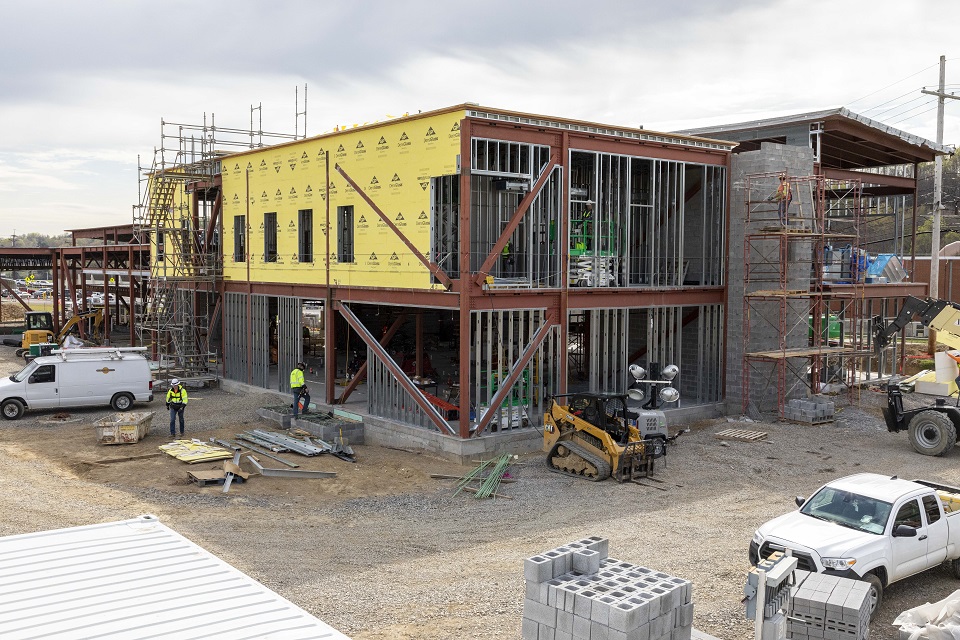
This construction site (photo from April 2022) will one day house the Y-12 Fire Department, replacing a facility that was built in the 1940s.
There is a lot of progress taking place at the construction site that will soon house the Y-12 Fire Department. Steelworkers placed the last piece of major structural steel on the new fire station, marking a major milestone in the project by achieving “topping out.”
“The ‘topping out’ is another symbolic milestone in construction,” said Jim Blair, CNS project manager. It reinforces that progress is being made toward a new operating facility that will house emergency response personnel, which is long overdue.”
“Concrete slabs have been placed and masonry walls have gone up, along with roofing,” Blair said. “Electrical and mechanical rough ins and wall framing are also going up.”
Y-12 Fire Chief Scott Vowell is excited about the pace of the project.
“With just a little imagination, you can envision what the fire station will be like. You can see where the fire-station designed rooms will be set up to maintain our emergency medical supplies, the hazardous materials suites and equipment, and the decontamination area and living quarters, just to name a few,” said Vowell.
The new fire station is replacing a facility that was built in the 1940s. The building does not meet the needs of a modern fire department and has deteriorated over time, requiring several areas to be cordoned off because of safety concerns.
Vowell said the new facility represents more than just a location move. It’s also about moving to an improved day-to-day lifestyle and attitude.
“To move from one of the original buildings to a state of the art, fire designed building, will have a lasting effect on our firefighters,” Vowell said.
The fire station is expected to be operational in early 2023.
It, along with the new Emergency Operations Center that is taking shape a few blocks west on First Street, are both NNSA pilot projects designed to streamline efficiency and delivery of specific construction projects under $50 million by adopting more cost effective commercial building practices where possible.
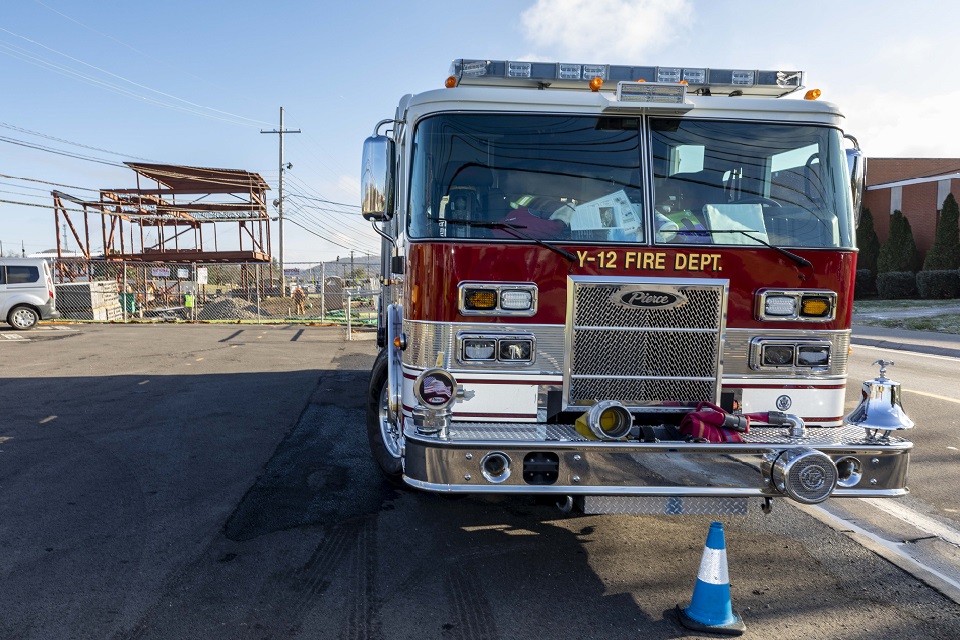
A Y-12 fire truck sits near its soon to be home.
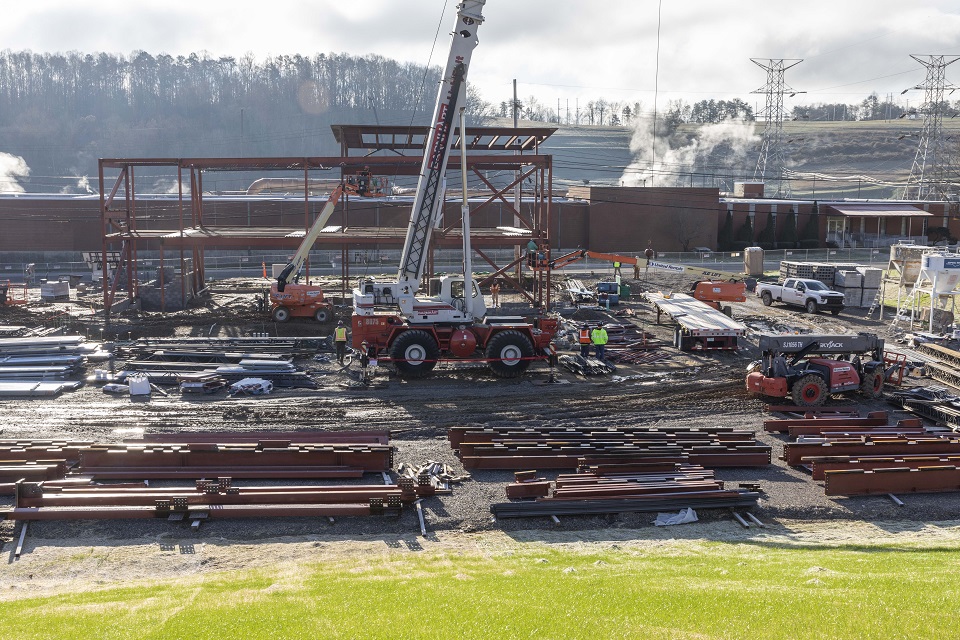
Fire station construction, February 2022
